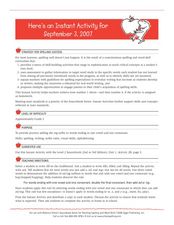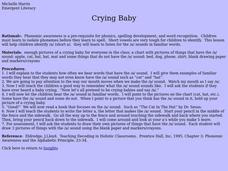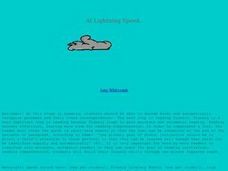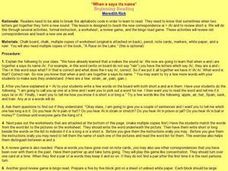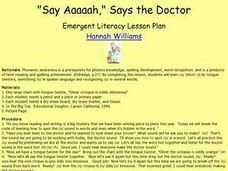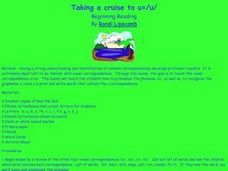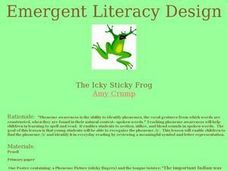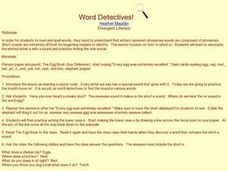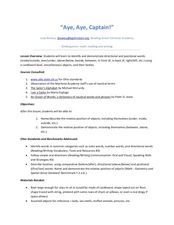Curated OER
Practice Adding the ing Suffix
Second graders practice adding ing to words ending in one vowel and one consonant. In this adding ing lesson, 2nd graders participate in a teacher demonstration of adding suffixes to one vowel, one consonant words. They learn the rule...
Curated OER
Crying Baby
Students explore phonemes. They discuss the short a sound. Students discuss the shape their mouths make when saying /a/. They read familiar words with the /a/. Students read "The Cat In The Hat." They identify words with the short a sound.
Curated OER
Bright Mice
Kindergarten through second graders explore the long i sound. In this phonics lesson, they read The Mother's Day Mice, sing "Farmer in the Dell," and play I Spy with long i in order to explore the target sound. Additionally, there is a...
Curated OER
At Lightning Speed
Review how to decode words and practice repeated readings for fluency. Kids review the cover-up method as a way to decode unknown words and then practice reading sentences for fluency and short passages with partners. They record their...
English To Go
Articles: A, An, The, or -
Help your young native English speakers discern between a, an, or the with this two-page document. Each article is explained before short practice assessments are offered. A short paragraph on the second page also explains what is known...
Curated OER
When A Says Its Name
Students are introduced to the concept of vowel digraphs. They identify the digraph /ai/ in spoken language. After a brief discussion, students apply the rule for reading and spelling words containing the /ai/ digraph by playing word bingo.
Curated OER
Say Aaaaah, Says the Doctor
Students explore the short /o/ sound using tongue twisters. They identify the /o/ sound in spoken language and recognize the /o/ in written words. Students practice writing the letter o. They spell words with the /o/ sound and they read...
Curated OER
Taking a Cruise To U=/u/
Students complete a variety of activities related to the short /u/ sound. As a class they recite a tongue twister, then spell different words containing the short /u/ using letter manipulatives. Students then read the book "Bud the...
Curated OER
Home Spelling Practice: Long I, Long O
In this spelling worksheet, students learn to spell a list of 20 words. All contain the sound of long O or long I. Students write each word one time on the lines.
Rock ’N Learn
Ned's Red Guitars – More Sounds of "ea"
In this vowel sounds worksheet, students analyze 14 pictures of guitars with long or short vowel A words printed in them. Students color red all guitars that have the same vowel sound as Ned's name. Students color gray all guitars that...
Curated OER
Astonishing "A"
Young learners gain phonemic awareness with this quick activity. First, point out what sound you’re focusing on today: /a/. Then spell basic words that use this sound, like fat, bat, cat, etc. As a culminating activity, the whole...
Curated OER
Polite Expressions
Practice effective oral language use. English learners especially, but any speaker/writers would benefit from this resource. Learners listen as the teacher reads each of 15 short scenarios. They circle the polite response to each...
Curated OER
Spelling and Thinking/ Short a
Students participate in a lesson that is concerned with the usage of spelling words that has the short "a" sound. They read the words in list form. Students also write the words in the "an" and "ad" word families.
Curated OER
Eewww, IIIcky Stiiicky
First graders imagine the sticky feeling of getting glue or gum stuck on their hands. They listen to the phrase "icky sticky" and repeat emphasizing the /i/ sound and work on recognizing the sound in several different word pairs and...
Starfall
Soap Boat
In this Language Arts learning exercise, students read a short book about a "soap boat." Students may practice reading it aloud and color in the illustrations.
Curated OER
High Frequency Words: lesson 27
In this high frequency words worksheet, students complete high frequency word activities by writing ou sound words, fill in the blanks to sentences, and answering short answer questions about stories. Students complete 4 activities total.
Curated OER
Juggling Bugs
Young scholars examine the letter 'u'. Through instruction and modeling they explore the sound the letter makes, how the letter is written, words that contain the letter, etc. They say tongue twisters with the /u/ sound in them. They...
Curated OER
The Icky Sticky Frog
Learners practice the strategy of phoneme awareness in order to identify phonemes with vocal gestures in spoken words. They blend letters and sounds together utilizing the phoneme /i/ by symbol and letter representation and listen as the...
Curated OER
Icky, Icky, Sticky!
Students explore phonemes in spoken words as well as their corresponding graphemes in written words. They practice the short vowels /i/ and /e/. Students perform activities to practice sounds. They identify pictures with a particular...
Curated OER
Open Wide
Students recognize the short vowel o in written and spoken language. Through matching activities, students discriminate the short vowel o from the long vowel o. They associate the phoneme with its letter representation and identify the...
Curated OER
Say Aaaaa for Apple
Learners say words by blending sounds and phonemes. They decode words in order to read and identify and understand the letter a. This phoneme /a/ is one of the short vowels that are needed to read and write. They will show example of...
Curated OER
Iggy and the Icky Sticky Inchworm
Students read and spell words. They have to recognize that letters stand for phonemes and spellings map out spoken words. Long and short vowels are hard to recognize and this instructional activity focuses on that. The short i is...
Curated OER
Word Detectives!
Students recognize the short vowel e in written and spoken language. Through matching activities, students discriminate the short vowel e from the long vowel o. They associate the phoneme with its letter representation and identify the...
Curated OER
Aye, Aye Captain
Students investigate how correspondences appear differently in different words. They also recognize the difference between long and short vowels. Students study how these correspondences are spelled and pronounced differently.
